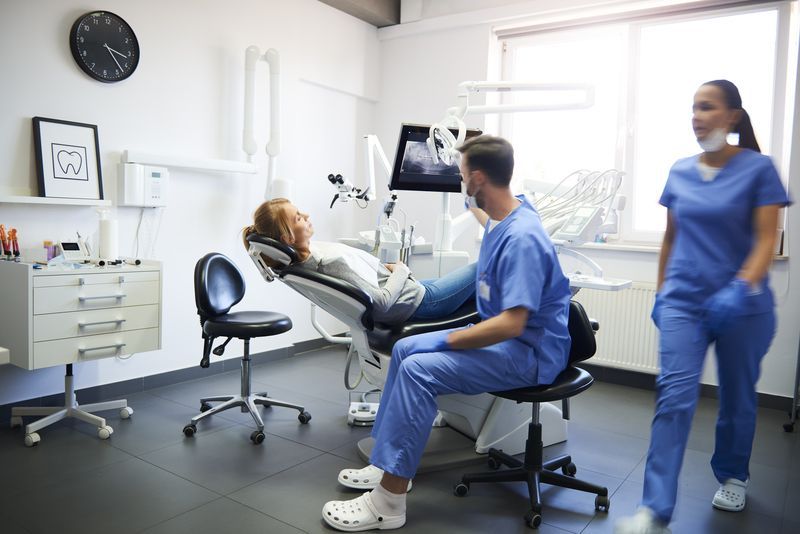Exploring the Impact of Augmented Reality in Dental Surgery Innovations

In the realm of dental surgery, a revolutionary tool is changing the landscape: augmented reality. Picture a world where dentists can see beyond what's immediately visible, enhancing their precision and effectiveness. Through accessible language and clear examples, it sheds light on how this technology is revolutionizing patient care and outcomes. Whether it's improving accuracy in implant placement or simplifying complex procedures, augmented reality is paving the way for a new era of dentistry.
The Intersection of Augmented Reality and Dentistry
Augmented Reality (AR) technology, a system that superimposes virtual images in the real world, is not just a marvel of the gaming and entertainment industry. It has found profound applications across various fields, including healthcare, manufacturing, and, notably, dentistry. AR's capability to blend digital content with the physical environment has opened up new avenues for innovations, particularly in improving the precision and efficacy of dental surgeries.
The journey of AR into medical practices dates back to the early 1990s when it was primarily used for advanced surgical procedures and training. Its ability to provide a composite view of patient anatomy without making an incision revolutionized how surgeons approached complex operations. This integration of AR into healthcare set the stage for its adoption in more specialized fields like dentistry, where precision is paramount.
In dentistry, AR's foray has been nothing short of transformative. Its application spans from educational purposes to complex surgical procedures. Dental students can now visualize and interact with complex anatomical structures through AR simulations, gaining a deeper understanding without the need for physical models. For practicing dentists, AR introduces a layer of precision in diagnostics and surgical planning that was previously unattainable. Through AR glasses or screens, dentists can view enhanced images of the patient's dental structure, overlaying detailed 3D models of teeth and gums over the actual mouth. This real-time visualization aids in planning and executing surgeries with higher accuracy and confidence.
The adoption of AR in dental surgeries marks a significant leap towards minimally invasive techniques, reducing the risk and discomfort associated with traditional surgical methods. From implant placements to corrective jaw surgeries, AR guides dentists through complex procedures, enabling them to navigate critical anatomical landmarks with live, augmented visuals. This not only shortens the surgery duration but also significantly improves recovery time for patients, making dental surgeries safer and more bearable.
Indeed, the integration of Augmented Reality into dentistry is pioneering a new era of surgical precision and patient care. As this technology continues to evolve, its application in dental practices promises to enhance not only the outcomes of dental surgeries but also the overall patient experience.
Educational Benefits of AR in Dental Surgery
The advent of Augmented Reality (AR) in dental education has fundamentally transformed how dental students learn and engage with their subject matter. Through AR simulations, students can now immerse themselves in a detailed, interactive learning environment, experiencing complex dental procedures in a virtual space. This hands-on approach significantly enhances their understanding and retention of information. AR offers real-time, 3D visualizations that allow trainees to dissect each layer of the human dentition without the limitations of 2D images or the need for physical models. For experienced dentists, AR facilitates continuing education, providing a platform to update their skills and knowledge with the latest surgical techniques, all at their own pace and convenience.
Pre-surgical Planning with AR
Pre-surgical planning is another domain where AR has made an indelible impact. By enabling accurate diagnostics and planning, AR technology significantly minimizes the margin for error, ensuring surgical interventions are both necessary and precisely targeted. Case studies illustrate how AR planning has led to a noticeable reduction in surgical errors, enhancing patient safety and surgical outcomes. By leveraging AR during patient consultations, dentists can offer a more comprehensive view of the proposed surgical process, setting realistic expectations and alleviating patient anxiety.
Enhanced Visualization Techniques During Surgery
AR's application extends into the operating room, where specialized visualization tools overlay critical information onto the surgeon's field of view during procedures. This real-time guidance system bolsters the dentist's ability to perform with unprecedented precision while adhering to minimally invasive techniques. The benefits are manifold, including elevated patient safety and significantly reduced recovery times, attributed to the decrease in surgery duration and physical trauma.
Real-world Applications and Success Stories
From dental implants to complex extractions, numerous dental surgeries have seen improved outcomes through the adoption of AR technologies. Dentists report a boost in confidence while operating, backed by AR's precise visual aids. Patients, on the other hand, benefit from quicker, safer procedures and shorter healing times. Testimonials from both parties underscore the tangible benefits AR brings to modern dental practice.
The Future of AR in Dentistry
The horizon for AR in dentistry stretches far beyond its current applications. Ongoing research is poised to introduce even more groundbreaking tools, potentially revolutionizing aspects like tele-dentistry and remote consultations. As the technology progresses, ethical considerations, particularly concerning patient data security, are paramount to ensure AR's sustainable integration into dental practices. Nonetheless, the potential for AR to further enhance dental care and education remains vast and largely untapped, promising an exciting future for the field.
Overcoming Challenges in Implementing AR in Dental Practices
The integration of Augmented Reality (AR) into dental practices heralds a new era of precision and patient care. The journey towards widespread adoption is fraught with challenges, ranging from technical hurdles to financial and training barriers. Firstly, the technical sophistication required to develop and maintain AR systems can be daunting. High-quality AR necessitates substantial computational power, advanced software, and robust hardware, all of which require significant investment. For a seamless AR experience, dental practices must ensure their systems are interoperable with existing digital dental records and imaging software.
Financially, the upfront costs of AR technology can be prohibitive for many practices. The investment doesn't stop at purchasing equipment; ongoing maintenance, software updates, and training represent continuous expenses. Securing funding and demonstrating a clear return on investment is crucial for practices considering AR adoption. Training presents another significant barrier. Both dentists and support staff need to familiarize themselves with AR technology to utilize it effectively. This demands time and resources that many busy practices can struggle to allocate. The payoff in enhanced surgical outcomes and patient satisfaction can justify this investment. Strategies for integrating AR into dental practices thus include phased adoption, seeking external funding (e.g., grants or partnerships with technology providers), and prioritizing staff training to mitigate these barriers.
Conclusion
Augmented Reality is setting a new standard in dental surgery, offering educational benefits, aiding in pre-surgical planning, and enabling enhanced visualization techniques. Real-world applications of AR in dental procedures, from implants to extractions, have demonstrated its potential to significantly improve outcomes, reduce surgery times, and enhance patient recovery experiences. Looking forward, the future of AR in dentistry is bright, with ongoing research promising even more innovative applications. The potential expansion into tele-dentistry could provide remote consultations with the same level of precision as in-person visits, further revolutionizing patient care.
Ethical concerns and patient data security must be at the forefront as these technologies develop, ensuring that the use of AR remains beneficial and secure for all parties involved. The journey toward full AR integration into dental practices is complex and challenging, but the benefits are undeniable. As we overcome these hurdles, AR stands to not only transform dental surgery but redefine dentistry as a whole, ensuring better care for patients worldwide. The transformative potential of AR in dentistry is immense, underscoring the importance of embracing this technology. Its capacity to enhance learning, improve surgical precision, and ultimately, better patient outcomes, paints a promising future for dental care—a future where technology and healthcare go hand in hand to provide the best possible treatment solutions.
Embark on a journey to redefine dental surgery with NextGenDent’s state-of-the-art Augmented Reality solutions. Contact South Temple Dental to learn more and get in touch with us today.


Connect With Us on Facebook
Areas We Serve
Downtown Salt Lake City
84103, 84116, 84104, 84101, 84111, 84102, 84112, 84113, 84108, 84105, 84115, 84104, 84103
Business Hours
- Monday
- -
- Tuesday
- -
- Wednesday
- -
- Thursday
- -
- Friday
- -
- Saturday
- Closed
- Sunday
- Closed
All Rights Reserved | South Temple Dental
Dentist in Downtown Salt Lake City, Utah
